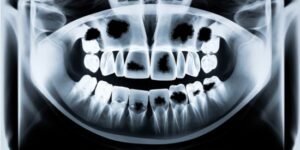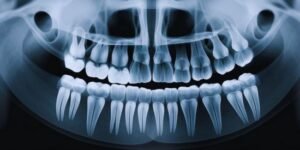Why Is a Child’s Dental X-ray Important?
“Read on to know why child’s dental x-ray play a vital role in your child’s oral health. Here are 15 common reasons for a dental x ray, including finding cavities, monitoring the growth of teeth, spotting impacted teeth and checking a tooth for an injury. Learn how dental x rays to be safe and vital for your child’s health.”

Dental X-rays are a vital diagnostic tool that enables pediatric dentists to discover potential oral health problems that may not be seen during a routine dental exam. These images aid in monitoring the health and development of your child’s teeth, gums, and jaw so that any issues can be addressed as soon as possible. Dental X-ray images are crucial for children because their teeth and jaws are still growing and developing. Moreover, jaw pain during pregnancy is also a major issue that parenting parents also face.
There are many possible problems that may go undetected as children’s teeth develop, and without a child’s dental X-ray imaging, they will not be caught in time. “How about cavities in areas that are difficult to reach with a toothbrush or areas that you cannot see while doing a standard exam?” These problems are easily identified with regular dental X-rays, which help provide more straightforward and efficient treatments before they turn into more serious issues.
The most important advantage of the child’s dental X-ray images is that they give a view of what is going on underneath. They provide pediatric dentists with a clear view of how the teeth are coming in, how the roots are coming in, how the bite is aligning, and even when wisdom teeth are coming in. So, they can schedule ahead and address things before they become painful or hard to treat.
Furthermore, parents need to be concerned that dental X-rays are safe for children. Modern dental X-ray technology exposes the patient to extremely low doses of radiation, making it very safe for young patients. A child’s dental X-ray is done with great care, only exposing your child to the minimum amount of radiation required to get an image.
1. Top 15 Major Reasons Your Child Requires a Dental X-Ray
1. 1 Identify Tooth Cavity Between the Teeth
Between teeth, however, there is often tooth decay that cannot be seen with the naked eye. Here, the child’s dental X-ray images come into play. “We can catch cavities between teeth that can’t be seen on the surface — it will show up here — and can get in there before the decay gets large or painful.”
Without a child’s dental X-ray, these cavities can go unseen until they worsen, putting a child at risk for infections or the necessity of expensive dental work like root canals or tooth extractions. Regular dental X-rays ensure that tooth decay is identified as early as possible so your child can have a healthy, happy smile.
1. 2 Monitor Tooth Development
While your child’s primary (baby) teeth are shedding and their permanent teeth are coming in, be sure to keep an eye on the progression of the teeth under the gums. Pediatric dentists use children’s dental X-ray images to monitor this process. These X-rays can reveal whether permanent teeth are coming in properly and whether there are any developmental abnormalities that may lead to misalignment.
Dental x rays are helpful in monitoring tooth development and detecting issues early, so that extensive orthodontic treatments can be prevented in the future. If their permanent teeth are coming through at an abnormal angle or being delayed in erupting, early intervention will help eliminate more serious complications later on.
1. 3 Identify Impacted Teeth
An impacted tooth is when a tooth (like a wisdom tooth) doesn’t fully come into the mouth. This is particularly true with wisdom teeth in late teens. Dental x ray images of children are essential in uncovering impacted teeth that could go unnoticed otherwise lying underneath the gums. However, if impacted teeth are left untreated, they can cause pain, infection, or shift the other teeth from place.
A child’s dental X-rays are essential for pediatric dentists to anticipate the impact of teeth. The sooner things are caught with a child’s dental X-ray, the fewer procedures are needed, the dentist will make sure less complicated treatment is performed if possible; his job will be to save your child from complications.

1. 4 Assess Bite Alignment
Bite alignment is important to your child’s overall oral health. But when the teeth or jaw are misaligned, that can have adverse consequences, ranging from difficulty chewing to issues with speech — not to mention discomfort. Pediatric dentists use a child’s dental X-ray photos to see how the teeth fit together and whether they’re properly aligned or whether they may affect your child’s bite.
You basically provide your child with the best opportunity to correct these issues with orthodontic treatment before they develop or get worse by recognizing these issues early through dental X-rays. Treating misalignment in the bite early can prevent your child from needing more painful or complicated procedures in the future.
1. 5 Evaluate Injury Impact
Kids just love moving around, and you can never expect when a dental injury can happen. Dental X-rays are essential to determine the full extent of a dental injury, whether it is caused by a fall, a sports injury or a blow to the head. These X-rays can show fractures in the teeth, damage to the roots, or problems with the bone structure around the teeth.
Pediatric dentists rely on a child’s dental x-ray images to visualize damage that is not always visible on the surface so they can plan appropriate treatment to prevent long-term complications such as infection or misalignment following an injury. Dental x-rays are an important part of early intervention in your child’s dental injury in order to ensure the most effective treatment and prevention of further damage.
1. 6 Plan Orthodontic Treatment
Treatments, such as braces, are most effective when they are planned based on a child’s oral development. Dental X-rays work for children because, with the help of a pediatric dentist and orthodontist, they can see the position and alignment of primary and permanent teeth. These images give an accurate picture of the teeth, roots, and jaw, making formulating a detailed, personalized treatment plan easier.
Pediatric dentists can decide the most optimal time to begin orthodontics using dental x-rays. They can also predict braces or other treatments your child might need in the future. Planning ahead with a child’s dental x-ray images will help you to ensure that the orthodontic treatment is done in the most effective manner.
1. 7 Detect Bone Diseases
Certain diseases or disorders affecting the jawbone, for example, can be challenging to detect without dental x-rays. These conditions may include bone infections, cysts, or other diseases that affect the jaw and teeth. Pediatric dentists can diagnose many such diseases at an early stage with the help of a regular child’s dental X-ray images so they can treat them early and prevent further complications.
Jaw bone diseases can lead to serious damage to your child’s teeth and to their overall oral health. Pediatric dentists may detect these problems early using dental X-rays, allowing your child to receive early treatment to prevent things from getting worse.

1. 8 Monitor Root Development
The root system is the underground structure of the tooth, the one that provides stability and helps the tooth to last for life. As your child’s teeth develop, so do the roots underneath the gums. The most accurate method to track the growth of teeth roots and to see if they are forming properly is to take dental X-rays. Root problems, inadequate root formation, etc., result in tooth laziness or premature tooth loss.
Frequent child’s dental x-ray photos help pediatric dentists keep track of the roots of developing teeth, as they are instrumental in making sure that your child’s teeth are solid and stable. Catching any root problems early on with dental X-rays gives dentists the time to rectify the problem beforehand and prevent it from coming back to haunt them later down the track.
1. 9 Identify Infections
Infections such as abscesses can form without visible symptoms and cause serious complications if untreated. Dental X-ray images obtained from children assist pediatric dentists in identifying dental, gum or jaw infections not visible to the naked eye. One of them is an abscess, a pocket of pus due to bacterial infection that can be deep in the tooth or surrounding bone. If these infections are left untreated due to the absence of a child’s dental X-ray imaging, the patient may experience tremendous pain or even damage to the tooth or bone structure.
Dental X-rays allow pediatric dentists to detect infections at an early stage when they have not yet developed into a serious health hazard. The sooner they are diagnosed, the sooner they can get treated, meaning less invasive procedures and less discomfort for your child. For children with tooth decay, for the most part, considered at risk of tooth decay, a child’s dental x-ray check-ups are important.
1. 10 Guide Tooth Extraction
Sometimes, dental extraction can become necessary, whether because of decay, damage or misalignment. Dental X-ray of child images are important because they contain detailed information that pediatric dentists use to determine the safest and most efficient extraction plan. The X-ray helps the dentist access the exact location of the tooth, its roots, and surrounding bone structure to prevent damage to nearby teeth and tissues while extracting the tooth.
If a tooth requires extracting — particularly if it is a permanent tooth — the child’s dental x ray aids in deciding the appropriate removal technique. Pediatric dentists utilize thorough X-ray imaging to conduct the extraction with greater accuracy, minimizing the potential for complications and providing a quicker recovery for your child.
1. 11 Evaluate Space Issues
A common concern with growing children is their incoming permanent teeth and whether or not there will be enough space. When there’s no room in the jaw, it can create crowding that leads to crooked teeth or misalignment. A child’s dental X-ray images let pediatric dentists see the amount of available space in the jaw and assess whether there is room for the permanent teeth to come through correctly.
Yes, spacing problems can be resolved naturally, but by using dental X-rays to evaluate the spacing issues, pediatric dentists can predict forthcoming alignment problems and plan accordingly. Early treatments may include spacers or dental expansion devices, which can help create considerable room for the teeth and lessen the need for more extensive orthodontic treatments in the future.

1. 12 Detect Missing Teeth
Some kids are born missing one or more teeth, a condition referred to as congenital tooth absence. Dental x-ray imaging for children can show a child’s missing teeth at an early life stage, assisting pediatric dentists in making an informed interventional plan. More often than not, if detected early, the dentist will monitor jaw development and determine if any orthodontic or surgical approach will be required to fill the gap for the missing teeth.
For instance, if a wisdom tooth is congenitally missing, the child’s dental x ray can show this, so that your child’s have a plan of treatment that specifically addresses the gap. This can help prevent potential complications in the future, such as bite challenges or bone loss in areas where teeth are absent.
1. 13 Monitor Wisdom Teeth
Wisdom teeth are the final set of molars to come in, usually during late adolescence or early adulthood. Dental x-ray images are necessary for monitoring the development of these teeth as they may come in at weird angles or become impacted. Pediatric dentists use dental X-rays to monitor the growth of wisdom teeth and determine when is best for removal to avoid pain infection or misalignment of the other teeth.
A child’s dental X-ray images usually help track their wisdom teeth early on for possible extraction or surgical treatment later on at the optimal time to reduce the need for further dental treatment down the road.
1. 14 Assess Periodontal Health
The state of the gums and supporting bone structure is essential to your child’s overall oral health. Regardless, cone beam computed tomography and dental x-rays establish periodontal health (e.g. bone density surrounding teeth) and gingival health. Issues such as gum disease, bone loss, or infections may be invisible without dental X-rays and can have a serious impact on your child’s oral health if you let them go untreated.
Dental x rays for kids assist pediatric dentists in detecting early signs of periodontal issues before your child shows any visible symptoms. Dental x rays can detect gum disease and bone loss before they can be visible to the naked eye, allowing many effective treatments such as deep cleanings, medications, and even simple surgical procedures.
1. 15 Plan Preventive Care
Your child will need preventive dental care to keep their teeth healthy, and child dental x-ray images are a great help in the planning of such care. Your child’s current oral health status can be evaluated by pediatric dentists with the use of dental X-rays, which will help identify any risk factors that may put your child’s teeth and gums at risk and allow for early signs of decay or malocclusion (misalignment) to be spotted.
This information allows pediatric dentists to create personalized preventive plans designed especially for your child’s individual requirements. For instance, if a child’s dental x-ray shows pesky weak spots in teeth, a dentist might suggest fluoride treatments or sealants keep the teeth from decaying. However, early intervention can spare your child more complicated treatments down the line.
2. How Soon Should Kids Start Having Dental X-rays?
How often your child needs dental X-rays depends greatly on their individual oral health needs, age, and history. A child with a history of multiple cavities or one who has other unusual symptoms (e.g. persistent tooth pain or swelling) may require more frequent child’s dental X-ray exams.
Usually, a child’s dental x-ray imaging is recommended around the age of 5 or 6 for most children when your kid gets his or her first permanent teeth. However, suppose your child has a greater risk for oral health problems, for example. In that case, if there is a family history of dental problems or if a child has experienced significant dental trauma or may need to undergo orthodontic treatments earlier, more frequent X-rays may be required.
Your pediatric dentist will evaluate your child’s specific needs, and will advise an appropriate X-ray schedule. Dental x rays at every appointment are not generally required — as with adults with two sets of dental x-ray images taken over the past decade, children’s x rays are common only when an issue arises or on a routine basis to keep track of developing issues.
Regular child’s dental x ray exams allow the dentist to detect dental issues in the early stages and treat them to prevent them from becoming more serious, thereby making treatment less intensive. If visiting the dentist due to any oral issues, do not shy away from discussing about dental x rays — they are essential for maintaining dental health along with overall health as well.
3. Safety Considerations
When it comes to dental procedures, safety is always a top priority, and this includes a child’s dental X-ray exams. Dental radiography is very safe for children as modern dental X-ray technology uses very low levels of radiation, and these levels have been shown to be safe. Dentists practice every precaution when doing a child’s dental X-rays to mitigate any risks — wearing lead aprons and thyroid collars to protect your child’s body and the major organs from needless exposure.
The cool thing about modern dentistry, though, is that x-rays have become safer and safer over the years thanks to improvements in dental imaging technology. In fact, a child’s dental X-ray methods pose much lower risks than they did just a generation ago. Furthermore, the dental community follows stringent guidelines regarding how often X-rays can be taken, with dental X-rays being done only when there is a clear clinical need. This limits any possible health risks.
If you are concerned about your child being exposed to too much radiation, ask your pediatric dentist. They can explain how these X-rays work and what safety precautions are in place and discuss how a child’s dental X-rays can help maintain your child’s oral health. The aim is always to make the most accurate diagnosis and provide the best treatment with the lowest risk.
It’s also important to keep in mind that a child’s dental X-rays are generally far less risky than the total exposure you receive from other varieties of radiation in everyday life, such as the cosmic rays from background radiation in our environment or medical imaging procedures like CT scans. Premium benefits with very little risk when imaging child’s dental x ray appropriately.
Conclusion
To sum it up, in your child’s oral hygiene patient, dental X-rays are your guide. Child’s dental x-ray images provide valuable insights that can help prevent more serious dental issues in the long run, from identifying hidden cavities to tracking tooth development and planning orthodontic treatments. Pediatric dentists use routine X-rays to catch problems early, ensure proper dental development and customize treatments that support your child’s overall health and well-being.
Parents also become more confident in making informed decisions about their child’s dental care by understanding the importance of a child’s dental X-rays. Nationwide, dental decay is the most prevalent chronic disease among children, making early detection through a child’s dental X-ray images vital in safeguarding your child’s teeth and ensuring a lifetime of healthy smiles.
Child’s Dental X-Ray FAQ: Here Are Some Common Questions
Q1. Are dental X-rays safe for children?
Answer: Are dental X-rays safe for children? Dentists perform low-radiation digital X-rays and take precautions like lead aprons and thyroid collars to reduce exposure. The risk of radiation is insignificant compared to the benefits of catching dental problems early. Dental X-rays are important for diagnosing cavities below the surface and tracking teeth development. If you have not received frequent X-rays, you must undergo them in order to treat dental issues quickly before they worsen.
Q2. Is this safe for a 5-year-old?
Answer: These X-rays taken under the guidance of professionals are safe for a 5-year-old. Pediatric orthodontists are trained in pediatric dentistry and are familiar with these rules, ensuring that any X-ray performed causes the least amount of radiation exposure for your child while still providing the necessary information to diagnose dental problems. At this age, a child’s dental X-ray goes a long way in monitoring the correct alignment of both baby and permanent teeth. Proper monitoring with X-rays prevents orthodontic problems down the road.
Q3. At what age can a child be X-rayed?
Answer: Dental X-rays age limit: There is no strict age limit. By age 2 or 3, a child might need an X-ray if he or she has concerns about cavities, tooth development or dental trauma. If you suspect your child may have a mental health condition, it is further recommended that he/she see a specialized mental health professional. X-rays use reveals better dental care and intervention.
Q4. At what age should children see a dentist?
Answer: Children should have their first dental visit by their first birthday or within 6 months of their first tooth erupting. Regular checkups every 6 months monitor dental health and prevent issues. These visits might involve a dental X-ray for the child to look for covert dental conditions. Regular dental visits and X-rays promote lifelong oral hygiene.
Q5. How many dental X-rays are appropriate for children?
Answer: How often a child will require dental X-rays depends on their oral health, age, and risk factors for cavities or other problems. Most children get X-rays annually or every two years, although those who have a higher risk of problems in the mouth may need them more frequently. The schedule for getting a dental X-ray done for a child is always individualized upon the child’s type of oral health needs. Routine X-rays allow dentists to recognize smaller problems before they become large ones.
Q6. Is a head X-ray safe for children?
Answer: Yes, head X-rays are safe for kids when they are needed and when appropriate protective measures are taken. To reduce the amount of exposure to the lowest possible level, it combines protective shielding and all-time low doses of radiation in order to perform examinations to achieve safety for patients to diagnose medical conditions. Dental X-rays of the top of the child can help us treat tooth and jaw arrangement issues. Diagnosis at an early stage with X-rays is advisable to rule out complications with jaw growth and align the dental structure.



